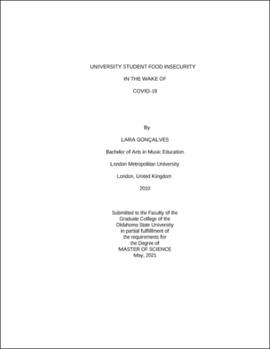| dc.description.abstract | Food insecurity is a ubiquitous problem in the United States rooted in inequality. At a time when higher education credentials are an essential pathway to economic stability and social mobility, college costs have risen, household income has stagnated, and the purchasing power of financial aid has declined. As a result, many low-income students in pursuit of breaking the poverty cycle struggle to secure their basic needs. With the COVID-19 pandemic disproportionately affecting those who are already disadvantaged, this study examines what factors are associated with increases in student food insecurity. This mixed-methods study draws upon a survey that was distributed to a random sample of 5000 students between April 2nd and April 30th, 2020. The quantitative phase of the analysis incorporates bivariate and multivariate methods to examine perceived social support, bonding and bridging forms of social capital, living arrangements, financial factors, age, and gender. The qualitative phase analyzes open-ended questions, employing an inductive data-driven approach. Findings reveal that social support is a key determinant of student food insecurity, which is particularly important given that this relationship has been arguably overlooked in the literature. Students utilized bonding (i.e. family) more than bridging (i.e., food bank, university pantry, community fridge, and community hub/group) social ties to access food at that time as lockdown measures limited the availability of the latter. Students who lived alone were more likely to experience food insecurity than those who lived with others. Students who moved back home with their parents were able to mitigate the condition by being provided with food and other resources. The utilization of student loans was positively associated with increases in student food insecurity. Food accessibility issues pertaining to the availability and affordability of nutritionally adequate food stemmed from panic buying, financial hardship, lack of transport, lockdown restrictions, social distancing measures, and fear of exposure to the virus. Overall, the results presented in this thesis show that students who were socially and financially disadvantaged were at increased risk of food insecurity in the wake of COVID-19. | |
